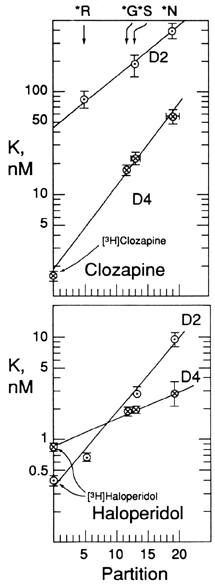
| Figure 2. |
 |
| The inhibition constant (K) for a neuroleptic at human cloned dopamine receptors depends on the tissue/buffer partition of the radioligand used to label the receptor. The intercept yields the radioligand-independent dissociation constant for the neuroleptic in the absence of any competing tritiated ligand. The tritiated ligands were [3H]nemonapride (*N), [3H]spiperone (*S), [3H]raclopride (*R) or [3H]Sandoz GLC756 (*G). The tissue/buffer partition coefficient for each tritiated ligand was measured on postmortem human caudate nucleus tissue (153, 164, 166); the coefficient is that amount of nonspecific binding occurring in the presence of 1 nM radioligand. The dissociation constants for [3H]clozapine and [3H]haloperidol were identical to the radioligand-independent inhibition constants for clozapine and haloperidol, respectively, as shown in Table 3. The Kd values of these tritiated neuroleptics are shown at a low partition (zero). This is because the tritiated ligand does not compete with any other compound for binding to the receptor. (Details in refs. 153,164,166). |
published 2000